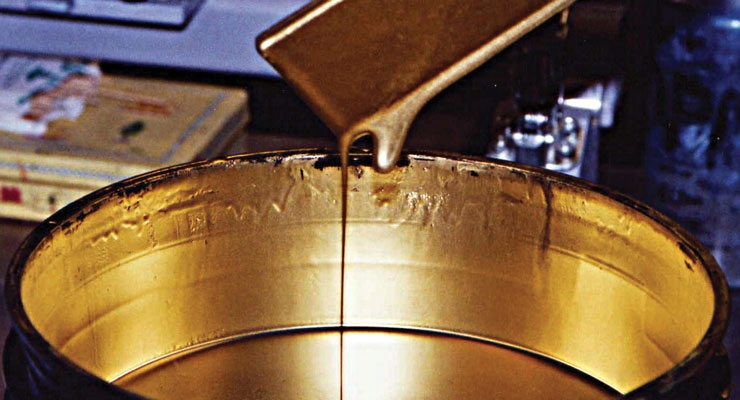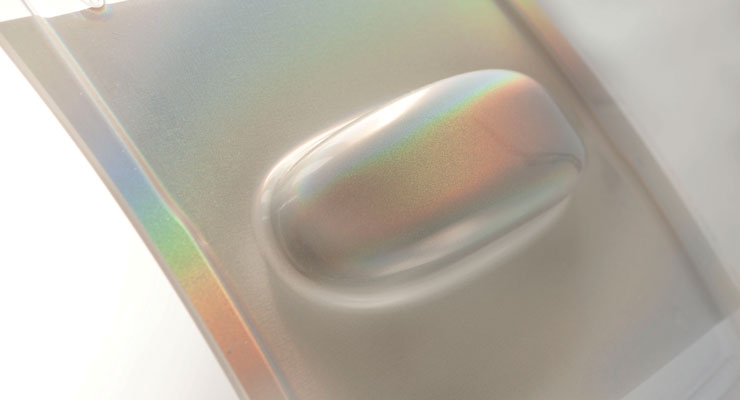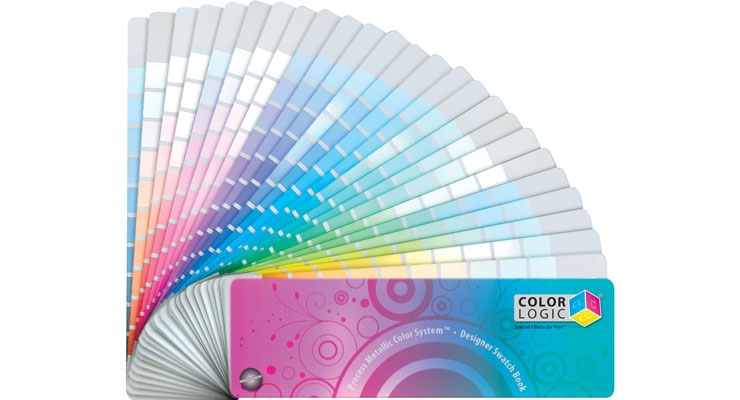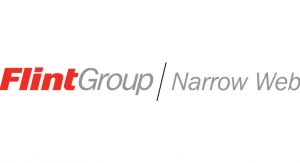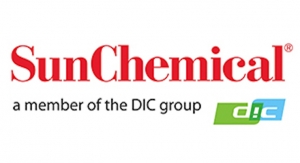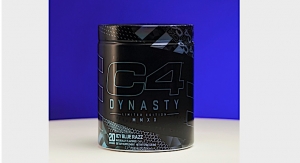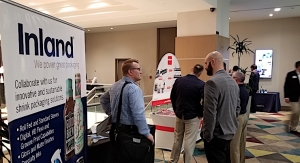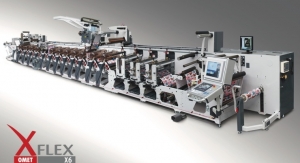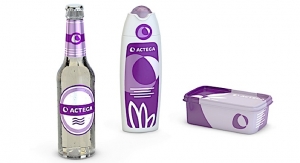Steve Katz, Editor04.09.18
Seven seconds, they say, is all you have on a competitive retail shelf to grab and hold a consumer’s attention. Eight seconds is the minimum amount of time needed for a rodeo rider to stay on a bucking bull or bronco in order to score. In other words, it’s even harder to grab a shopper’s attention to sell a product based on packaging than it is to succeed as a professional bull rider.
While the above comparison is a bit silly, it underscores the point that it’s no easy task to set a product apart from others. On-shelf competition is as fierce as ever, whether you’re selling toothpaste, liquor and everything in between, so when it comes to product packaging, brand owners need any edge they can get. Using metallic inks on labels is a strategy that can help, giving a product the added “pop” it needs to beat that seven-second clock.
Historically, brand marketing departments, keen on the advantages inherent in switching up product looks and creating more SKUs, have been using metallic inks as another tool in their arsenal. However, using a “bling” effect is more commonplace than it’s ever been.
Ed Dedman, flexo technical support manager for ink manufacturer Zeller+Gmelin, says, “We’ve seen over the years that the use of metallic inks on many consumer products seems to be somewhat cyclical, in that brand marketers will use products like metallics, fluorescents, pearlescents and foils to enhance brand image for a particular marketing campaign, then switch to a different enhancement for the next campaign, and so on. However, in recent years, for many well-known brands, the use of high sheen metallic silvers and/or metallic colors – inks that have been augmented by the addition of conventional pigments to create a Pantone or custom color that has a metallic sheen – has become a staple in the branding and marketing approach,” Dedman says, adding, “Particularly with packaging for hair color, cosmetics and a wide array of health and beauty products – metallics are being used on almost every brand and package design.”
Applications that feature metallic ink effects are everywhere, and it’s not just for aesthetic reasons but for economic ones as well. Clinton Melius, hubergroup’s North American flexo technical director, comments, “Wine, beverage and cosmetic industries utilize metallic inks to highlight logos, print borders around labels and enhance key highlights of a product, to name a few. Metallic inks are used to match all the Pantone ‘Premium Metallic’ color guide colors, and they are also used as cost-effective alternatives to expensive metal hot stamping and foil transfer processes. They provide the coveted ‘metallic reflectivity look’ at a more economical cost.”
Melius also stresses that improvements in ink formulations have helped drive metallic ink usage. He explains, “Advancements from metallic pigment suppliers, with finer particle-sized pigments and more user-friendly ink vehicles, have given ink formulators more latitude now to use low volume anilox rolls to print screens and fine text and still provide the strength needed to achieve the Pantone metallic color standards required by the label industry today.”
Niklas Olsson, global brand manager NW for Flint Group Narrow Web, notes that while the majority of label printers today achieve these looks with cold foil, hot foil, embossing, debossing or other traditional converting and decoration methods, in the end, he says, the most important decisions about whether or not to use metallic inks depend upon the choice of paper, preferred coating application, printing process and the desired effect.
Olsson explains, “Metallic inks are generally applied at a lower cost per label compared to foiling, and while many brands are initially introduced to metallic effects with top-notch quality foiling, experience shows that labels ‘evolve’ over time and go from foil-to-foil effect and, last, to just be standard silver. Cost being the main driver is especially important if brands and volumes get larger.
“There are many types of metallic inks on the market,” Olsson continues, “And this is mainly due to the pigment or particle structure used. One could say inks range from ‘small balls’ over to ‘cornflake look-a-like structures, and finally to the ‘foil look-a-like’ grade using Vacuum Metallized Particle (VMP) inks. Metallic effects are also dependent on print method, as well as ink chemistry.”
Mark Lambert, technical liaison – Labels & Flexible Packaging, ACTEGA North America, stresses that metallic inks have come a long way in their development, and their use has increased for a variety of reasons. He says, “Many brand owners are looking to improve the sustainability ratings for their packages, and metallic inks are a great choice because they can be removed from the recycling stream through the de-inking process. The inks themselves continue to improve as well – both in look and ease of application.”
Lambert adds, “For years, metallic inks have been used to denote high-end, top-of-the-line products resulting in the consumer feeling that they have purchased the best. I don’t think that will ever change. The Olympics remind us every four years that the best of the best should wear a gold, silver or bronze ‘label.’”
What follows is a look at some of the ink products today that sparkle and shine, as well as more thoughts from the metallic ink experts.
ACTEGA, a member of ALTANA
ACTEGA’s latest generation of metallic ink products, Lambert says, are lower in viscosity, higher in pigment load and have excellent stability. “The have allowed printers to use finer line and lower volume anilox rollers. These advancements have also dramatically improved the final print quality and significantly increase the brilliance of the finished products.”
ACTEGA North America supplies a full line of ACTEGA branded aqueous and UV-curable metallic inks for label printers. These products range from standard silvers (877) and golds (871-876) to metallic color matches per the PMS book, as well as special requested matches. “In addition, we have bright and bright-trappable versions of silver and gold, allowing the printer the ability to provide more brilliance for their customers. Also, both UV and aqueous products provide ‘scratch-off’ inks for the security and lottery market segments,” Lambert says.
ACTEGA North America offers metallic flexographic inks in both aqueous and UV systems, in addition to a full line of UV metallic screen inks. Silver and gold are also available for shrink sleeve applications.
According to James Harris, ACTEGA North America's North American business manager – Labels, the company’s most popular metallic brand is the MiraFoil line, which is recognized and specified by many brand owners as it provides a foil-like brilliant silver finish.
“MiraFoil is often used to eliminate the need for conventional metallic board or paper or replace hot stamping, especially when only one part of the label requires a metallic effect,” Harris explains. “It can also be overprinted with conventional water-based and UV inks to provide thousands of metallic colors at a moment’s notice. This helps reduce the waste of costly metallic inks left over from a job, as well as reducing the number of metallic inks needed on hand.”
As a proactive and innovative supplier to the label industry, ACTEGA created a color selector guide that designers and printers can use to create their own text, logo and/or graphic designs. This guide contains over 1,100 PMS colors that visually display the appearance of MiraFoil over conventional inks.
Flint Group Narrow Web
“We provide all types of metallic inks – from UV letterpress, UV offset, UV flexo and water-based flexo all the way across to gravure/solvent inks. We offer both ‘conventional’ metallic effects, as well as the high-quality foil-effect types,” Olsson says.
Recent Flint Group R&D has led to the development of metallic effect inks with low migration properties – in all print methods – with the highest priority for UV flexo and UV offset. “We also have developed LED curing metallic inks – as this was in high demand from converters using this fast growing technology,” says Olsson.
“All our efforts are based on providing a service to our clients,” Olsson continues. “We will provide the products they require and also the best-in-class application knowledge required to succeed. We have, for example, worked hard to ensure our ‘normal inks’ are fully compatible, over-printable with metallic inks – regardless in which sequence or combination it’s intended to be used.”
Olsson concludes that it is very important for each application to know and master the full supply chain. He says, “It’s critical to use the right combination of release varnish and masking inks, but this is a separate topic that requires consideration to master fully.”
INX International Ink Co.
INX offers its AquaTech ION SHEEN and AquaTech ION SHEEN PLUS to the label industry. The SHEEN PLUS, INX says, provides converters with the brightest, richest luster metallic ink, using true bronze flake in its formulation. “The SHEEN system involves a toned 877 silver that provides a vibrant metallic appearance at a more economical price point,” says Jim Kristulic, product manager, Tag & Label for INX International Ink Co. “Both the ION SHEEN and ION SHEEN PLUS systems incorporate a very stable vehicle system, providing for extended shelf life, excellent transfer abilities and brilliant appearance.”
HuberGroup
hubergroup’s Metaluster water-based metallic inks have been well received in the label industry, according to Melius. “Full strength Pantone metallic colors can be achieved using a 700 cell per inch, 2.8 BCM anilox roll, thus allowing a printer to achieve great results printing small text, crisp lines, various screens and solids, all with excellent coverage on most label substrates,” Melius says.
The Metaluster ink system utilizes the smallest metallic pigment particle size in the industry, he adds, which allows more pigment to be used in a formulation while still maintaining low viscosity and great printability. “The small particle and proprietary ink vehicles allow printers to achieve clean printing on screens and text while achieving sharp edges that cannot be done with larger particle sized metallic ink systems,” he says.
The Metaluster ink system is available in the standard Pantone 871 to 877 metallic colors and also available in all the “Premium Metallic” colors. Metallic ink color drawdowns are available in hubergroup’s water-based and UV light curable (UV and LED) flexo ink systems upon request.
ECKART, a member of ALTANA
“The ongoing challenge of brand owners is how to differentiate from each other to gain that edge. Metallic and special effect inks act as the luxurious attractant for gaining shelf appeal of the consumer,” states Scott Schultz, market development manager – Graphic Arts, at ECKART America. “The upward trends still exist in PS labels where inks are growing as a choice for bright foil appearances. Shrink sleeves are also growing, and there is an increasing demand for metallics, especially UV LED. Another unique area of interest is with holographic effects on labels. Today, prismatic inks, such as our PRISMASTAR, can be utilized as a cost alternative to other techniques commonly used for holographic effects.”
A product recently launched that ECKART is excited about is its ULTRASTAR UV LED Select FP-58850. “This is an outstanding milestone in gaining brilliance for UV LED flexo printing,” Schultz says.
Innovations in ECKART’s METALURE pigment technology has it formulated to to be an ideal alternative to hot/cold foil stamping and metalized substrates. Schultz says, “Thanks to improved mileage, adhesion and curing properties, this new silver ink is positioned to become an optimum choice for high quality at a reduced cost versus other decorating technologies. In addition to featuring high brilliance and being foil-like at a reduced cost, it is stable and compatible with UV LED curing for flexo printing. It’s also BPA-free with components conforming to the Nestle exclusion list.
ECKART also has a new sub brand and communication concept called “illoom,” which creates a new platform for discussions with design agencies and brand owners on the subject of metallic effects. Explains Schultz, “illoom gives us the opportunity to influence brand owners and design agency projects at an early stage in the design process by understanding the challenges that designers and brand owners face when including metallic effects on packaging.”
Zeller+Gmelin
Zeller+Gmelin offers a full portfolio of metallic inks, in both the regular Pantone pure metallic golds and silvers, as well as the ability to match any Pantone metallic color from their guide or any custom metallic color. The 150-year old company offers these products in UV and water-based chemistries for all label and packaging applications, including labels, shrink sleeves, flexible packaging, pouches and folding cartons, as well molded cups, tubes and lids.
“Whether it’s the added sparkle and shine of a metallic gold or silver, or the ‘luxury’ associated with a metallic color, metallics in general are definitely considered a step above conventional non-metallic colors,” states Dedman.
Sun Chemical
Sun Chemical recently introduced a set of migration-compliant metallic inks for sheetfed offset printing. The new set, part of Sun Chemical’s SunPak FSP range of bio-based, lithographic inks for board and paper, comprises four colors – silver, rich gold, rich pale gold and pale gold. These products have been fully-certified as migration-compliant, and according to Sun Chemical, have been validated positively by customers, indicating the new range of metallic inks delivers good storage stability, is more robust on press compared with other migration-compliant inks and has drawn level with standard oil-based metallic inks in terms of metallic brilliance.
Cygient
A new player in the label market is Cyngient LLC, a specialty ink, coating and adhesive company with a focus on high-value products that deliver exceptional results. “Our UV Flexo Mirror Mold Brilliant Silver exhibits super high 300% plus elongation, with excellent bond to treated film substrates without cracking. As an example, Mirror Mold Brilliant UV Flexo Silver can be used to simulate stainless steel and is imprintable, creating unique metallic colored effects,” says Andrew Wasserman, Cyngient’s managing partner.
Brands—which today have more SKUs than ever—want their products to stand out on the shelf and get to market quickly. Labels with metallic elements can be very attractive to brands but are often a nightmare for both brands and their printers. Most graphic designers use Pantone metallic swatchbooks (labeled as guides) to lay out their metallic labels, but their swatchbooks were printed on offset presses, with conventional (not UV) inks, on offset stock, and not coated with the varnish used by label printers. The PMS colors and ICC color management used by converters and brands in the offset world are useless when it comes to metallics. The only way to effectively communicate metallic colors is to print a sample on the stock, with the ink and coating that will be used on the final labels. But using the press to settle on a final design is both expensive and time-consuming.
This is why a company called Color-Logic developed a system that documents what is possible on the press and then delivers the tools to converters and brands that will eliminate guesswork. Color-Logic grants printers and converters a license to produce their own swatchbooks, which will accurately communicate to brands and graphic designers at the design stage what is possible from the converter’s press.
With Color-Logic, silver is put down first, followed by CMYK inks on top. On foil, Color-Logic effortlessly creates the necessary white masks. This technique enables converters to consistently and reliably produce as many as 250 different metallic colors in one pass of the press. Working with only one silver and just four process inks reduces inventory, yet provides brands an economical system for creating the many additional colors often desired for a growing number of SKUs. And design time is reduced dramatically. Color-Logic enables printers to use the same system with foil, film, screen printing, hybrid, digital and offset processes.
While the above comparison is a bit silly, it underscores the point that it’s no easy task to set a product apart from others. On-shelf competition is as fierce as ever, whether you’re selling toothpaste, liquor and everything in between, so when it comes to product packaging, brand owners need any edge they can get. Using metallic inks on labels is a strategy that can help, giving a product the added “pop” it needs to beat that seven-second clock.
Historically, brand marketing departments, keen on the advantages inherent in switching up product looks and creating more SKUs, have been using metallic inks as another tool in their arsenal. However, using a “bling” effect is more commonplace than it’s ever been.
Ed Dedman, flexo technical support manager for ink manufacturer Zeller+Gmelin, says, “We’ve seen over the years that the use of metallic inks on many consumer products seems to be somewhat cyclical, in that brand marketers will use products like metallics, fluorescents, pearlescents and foils to enhance brand image for a particular marketing campaign, then switch to a different enhancement for the next campaign, and so on. However, in recent years, for many well-known brands, the use of high sheen metallic silvers and/or metallic colors – inks that have been augmented by the addition of conventional pigments to create a Pantone or custom color that has a metallic sheen – has become a staple in the branding and marketing approach,” Dedman says, adding, “Particularly with packaging for hair color, cosmetics and a wide array of health and beauty products – metallics are being used on almost every brand and package design.”
Applications that feature metallic ink effects are everywhere, and it’s not just for aesthetic reasons but for economic ones as well. Clinton Melius, hubergroup’s North American flexo technical director, comments, “Wine, beverage and cosmetic industries utilize metallic inks to highlight logos, print borders around labels and enhance key highlights of a product, to name a few. Metallic inks are used to match all the Pantone ‘Premium Metallic’ color guide colors, and they are also used as cost-effective alternatives to expensive metal hot stamping and foil transfer processes. They provide the coveted ‘metallic reflectivity look’ at a more economical cost.”
Melius also stresses that improvements in ink formulations have helped drive metallic ink usage. He explains, “Advancements from metallic pigment suppliers, with finer particle-sized pigments and more user-friendly ink vehicles, have given ink formulators more latitude now to use low volume anilox rolls to print screens and fine text and still provide the strength needed to achieve the Pantone metallic color standards required by the label industry today.”
Niklas Olsson, global brand manager NW for Flint Group Narrow Web, notes that while the majority of label printers today achieve these looks with cold foil, hot foil, embossing, debossing or other traditional converting and decoration methods, in the end, he says, the most important decisions about whether or not to use metallic inks depend upon the choice of paper, preferred coating application, printing process and the desired effect.
Olsson explains, “Metallic inks are generally applied at a lower cost per label compared to foiling, and while many brands are initially introduced to metallic effects with top-notch quality foiling, experience shows that labels ‘evolve’ over time and go from foil-to-foil effect and, last, to just be standard silver. Cost being the main driver is especially important if brands and volumes get larger.
“There are many types of metallic inks on the market,” Olsson continues, “And this is mainly due to the pigment or particle structure used. One could say inks range from ‘small balls’ over to ‘cornflake look-a-like structures, and finally to the ‘foil look-a-like’ grade using Vacuum Metallized Particle (VMP) inks. Metallic effects are also dependent on print method, as well as ink chemistry.”
Mark Lambert, technical liaison – Labels & Flexible Packaging, ACTEGA North America, stresses that metallic inks have come a long way in their development, and their use has increased for a variety of reasons. He says, “Many brand owners are looking to improve the sustainability ratings for their packages, and metallic inks are a great choice because they can be removed from the recycling stream through the de-inking process. The inks themselves continue to improve as well – both in look and ease of application.”
Lambert adds, “For years, metallic inks have been used to denote high-end, top-of-the-line products resulting in the consumer feeling that they have purchased the best. I don’t think that will ever change. The Olympics remind us every four years that the best of the best should wear a gold, silver or bronze ‘label.’”
What follows is a look at some of the ink products today that sparkle and shine, as well as more thoughts from the metallic ink experts.
ACTEGA, a member of ALTANA
ACTEGA’s latest generation of metallic ink products, Lambert says, are lower in viscosity, higher in pigment load and have excellent stability. “The have allowed printers to use finer line and lower volume anilox rollers. These advancements have also dramatically improved the final print quality and significantly increase the brilliance of the finished products.”
ACTEGA North America supplies a full line of ACTEGA branded aqueous and UV-curable metallic inks for label printers. These products range from standard silvers (877) and golds (871-876) to metallic color matches per the PMS book, as well as special requested matches. “In addition, we have bright and bright-trappable versions of silver and gold, allowing the printer the ability to provide more brilliance for their customers. Also, both UV and aqueous products provide ‘scratch-off’ inks for the security and lottery market segments,” Lambert says.
ACTEGA North America offers metallic flexographic inks in both aqueous and UV systems, in addition to a full line of UV metallic screen inks. Silver and gold are also available for shrink sleeve applications.
According to James Harris, ACTEGA North America's North American business manager – Labels, the company’s most popular metallic brand is the MiraFoil line, which is recognized and specified by many brand owners as it provides a foil-like brilliant silver finish.
“MiraFoil is often used to eliminate the need for conventional metallic board or paper or replace hot stamping, especially when only one part of the label requires a metallic effect,” Harris explains. “It can also be overprinted with conventional water-based and UV inks to provide thousands of metallic colors at a moment’s notice. This helps reduce the waste of costly metallic inks left over from a job, as well as reducing the number of metallic inks needed on hand.”
As a proactive and innovative supplier to the label industry, ACTEGA created a color selector guide that designers and printers can use to create their own text, logo and/or graphic designs. This guide contains over 1,100 PMS colors that visually display the appearance of MiraFoil over conventional inks.
Flint Group Narrow Web
“We provide all types of metallic inks – from UV letterpress, UV offset, UV flexo and water-based flexo all the way across to gravure/solvent inks. We offer both ‘conventional’ metallic effects, as well as the high-quality foil-effect types,” Olsson says.
Recent Flint Group R&D has led to the development of metallic effect inks with low migration properties – in all print methods – with the highest priority for UV flexo and UV offset. “We also have developed LED curing metallic inks – as this was in high demand from converters using this fast growing technology,” says Olsson.
“All our efforts are based on providing a service to our clients,” Olsson continues. “We will provide the products they require and also the best-in-class application knowledge required to succeed. We have, for example, worked hard to ensure our ‘normal inks’ are fully compatible, over-printable with metallic inks – regardless in which sequence or combination it’s intended to be used.”
Olsson concludes that it is very important for each application to know and master the full supply chain. He says, “It’s critical to use the right combination of release varnish and masking inks, but this is a separate topic that requires consideration to master fully.”
INX International Ink Co.
INX offers its AquaTech ION SHEEN and AquaTech ION SHEEN PLUS to the label industry. The SHEEN PLUS, INX says, provides converters with the brightest, richest luster metallic ink, using true bronze flake in its formulation. “The SHEEN system involves a toned 877 silver that provides a vibrant metallic appearance at a more economical price point,” says Jim Kristulic, product manager, Tag & Label for INX International Ink Co. “Both the ION SHEEN and ION SHEEN PLUS systems incorporate a very stable vehicle system, providing for extended shelf life, excellent transfer abilities and brilliant appearance.”
HuberGroup
hubergroup’s Metaluster water-based metallic inks have been well received in the label industry, according to Melius. “Full strength Pantone metallic colors can be achieved using a 700 cell per inch, 2.8 BCM anilox roll, thus allowing a printer to achieve great results printing small text, crisp lines, various screens and solids, all with excellent coverage on most label substrates,” Melius says.
The Metaluster ink system utilizes the smallest metallic pigment particle size in the industry, he adds, which allows more pigment to be used in a formulation while still maintaining low viscosity and great printability. “The small particle and proprietary ink vehicles allow printers to achieve clean printing on screens and text while achieving sharp edges that cannot be done with larger particle sized metallic ink systems,” he says.
The Metaluster ink system is available in the standard Pantone 871 to 877 metallic colors and also available in all the “Premium Metallic” colors. Metallic ink color drawdowns are available in hubergroup’s water-based and UV light curable (UV and LED) flexo ink systems upon request.
ECKART, a member of ALTANA
“The ongoing challenge of brand owners is how to differentiate from each other to gain that edge. Metallic and special effect inks act as the luxurious attractant for gaining shelf appeal of the consumer,” states Scott Schultz, market development manager – Graphic Arts, at ECKART America. “The upward trends still exist in PS labels where inks are growing as a choice for bright foil appearances. Shrink sleeves are also growing, and there is an increasing demand for metallics, especially UV LED. Another unique area of interest is with holographic effects on labels. Today, prismatic inks, such as our PRISMASTAR, can be utilized as a cost alternative to other techniques commonly used for holographic effects.”
A product recently launched that ECKART is excited about is its ULTRASTAR UV LED Select FP-58850. “This is an outstanding milestone in gaining brilliance for UV LED flexo printing,” Schultz says.
Innovations in ECKART’s METALURE pigment technology has it formulated to to be an ideal alternative to hot/cold foil stamping and metalized substrates. Schultz says, “Thanks to improved mileage, adhesion and curing properties, this new silver ink is positioned to become an optimum choice for high quality at a reduced cost versus other decorating technologies. In addition to featuring high brilliance and being foil-like at a reduced cost, it is stable and compatible with UV LED curing for flexo printing. It’s also BPA-free with components conforming to the Nestle exclusion list.
ECKART also has a new sub brand and communication concept called “illoom,” which creates a new platform for discussions with design agencies and brand owners on the subject of metallic effects. Explains Schultz, “illoom gives us the opportunity to influence brand owners and design agency projects at an early stage in the design process by understanding the challenges that designers and brand owners face when including metallic effects on packaging.”
Zeller+Gmelin
Zeller+Gmelin offers a full portfolio of metallic inks, in both the regular Pantone pure metallic golds and silvers, as well as the ability to match any Pantone metallic color from their guide or any custom metallic color. The 150-year old company offers these products in UV and water-based chemistries for all label and packaging applications, including labels, shrink sleeves, flexible packaging, pouches and folding cartons, as well molded cups, tubes and lids.
“Whether it’s the added sparkle and shine of a metallic gold or silver, or the ‘luxury’ associated with a metallic color, metallics in general are definitely considered a step above conventional non-metallic colors,” states Dedman.
Sun Chemical
Sun Chemical recently introduced a set of migration-compliant metallic inks for sheetfed offset printing. The new set, part of Sun Chemical’s SunPak FSP range of bio-based, lithographic inks for board and paper, comprises four colors – silver, rich gold, rich pale gold and pale gold. These products have been fully-certified as migration-compliant, and according to Sun Chemical, have been validated positively by customers, indicating the new range of metallic inks delivers good storage stability, is more robust on press compared with other migration-compliant inks and has drawn level with standard oil-based metallic inks in terms of metallic brilliance.
Cygient
A new player in the label market is Cyngient LLC, a specialty ink, coating and adhesive company with a focus on high-value products that deliver exceptional results. “Our UV Flexo Mirror Mold Brilliant Silver exhibits super high 300% plus elongation, with excellent bond to treated film substrates without cracking. As an example, Mirror Mold Brilliant UV Flexo Silver can be used to simulate stainless steel and is imprintable, creating unique metallic colored effects,” says Andrew Wasserman, Cyngient’s managing partner.
Brands—which today have more SKUs than ever—want their products to stand out on the shelf and get to market quickly. Labels with metallic elements can be very attractive to brands but are often a nightmare for both brands and their printers. Most graphic designers use Pantone metallic swatchbooks (labeled as guides) to lay out their metallic labels, but their swatchbooks were printed on offset presses, with conventional (not UV) inks, on offset stock, and not coated with the varnish used by label printers. The PMS colors and ICC color management used by converters and brands in the offset world are useless when it comes to metallics. The only way to effectively communicate metallic colors is to print a sample on the stock, with the ink and coating that will be used on the final labels. But using the press to settle on a final design is both expensive and time-consuming.
This is why a company called Color-Logic developed a system that documents what is possible on the press and then delivers the tools to converters and brands that will eliminate guesswork. Color-Logic grants printers and converters a license to produce their own swatchbooks, which will accurately communicate to brands and graphic designers at the design stage what is possible from the converter’s press.
With Color-Logic, silver is put down first, followed by CMYK inks on top. On foil, Color-Logic effortlessly creates the necessary white masks. This technique enables converters to consistently and reliably produce as many as 250 different metallic colors in one pass of the press. Working with only one silver and just four process inks reduces inventory, yet provides brands an economical system for creating the many additional colors often desired for a growing number of SKUs. And design time is reduced dramatically. Color-Logic enables printers to use the same system with foil, film, screen printing, hybrid, digital and offset processes.

